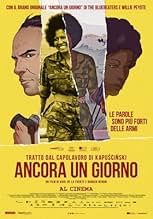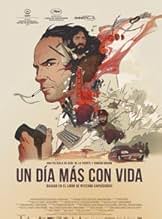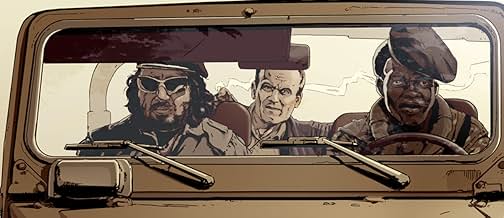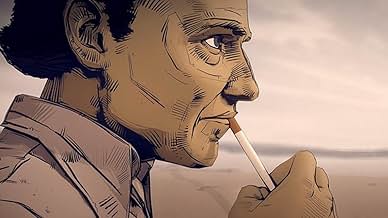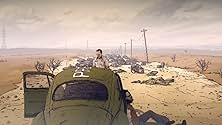A gripping story of a three-month-long journey that renowned Polish reporter Ryszard Kapuscinski took across Angola, ravaged by a war in which the front lines shifted like a kaleidoscope, fr... Read allA gripping story of a three-month-long journey that renowned Polish reporter Ryszard Kapuscinski took across Angola, ravaged by a war in which the front lines shifted like a kaleidoscope, from one day to the next.A gripping story of a three-month-long journey that renowned Polish reporter Ryszard Kapuscinski took across Angola, ravaged by a war in which the front lines shifted like a kaleidoscope, from one day to the next.
- Awards
- 14 wins & 9 nominations total
- Self
- (as Luis Alberto)
- Self
- (archive footage)
- (as Carlota)
- Self
- (as Farrusco)
- Queiroz
- (as Vergil Smith)
- …
- Queiroz
- (voice)
- Farrusco
- (voice)
- Carlota
- (voice)
- Friedkin
- (voice)
- …
- Portuguese soldier
- (voice)
- Dona Cartagina
- (voice)
Featured reviews
First, it's incredibly one-sided. For a work based on a journalist piece you would expect something that would recognize that there isn't "good or bad" in wars. We the purists vs the evil is something that simple doesn't happen and didn't happen in Angola at all. The MPLA killed, at least, as many as the other movements but that's not the impression you take from this. It would be good to show a bit about the other sides and their motivations (no, it was not only the American capitalism 😑).
Second, the story had a lot of potential but I just felt that it was not told in a compelling way. Yes, there are good parts. Yes, the bits about Carlota are emotional. Yes, some real testimonials are important. However, I felt that these episodes could have been told in a much more interesting way.
Third, I didn't feel this Angolan enough. You feel that this is made mainly for international consumption. People should have seen more from Angola; could have heard more about their music - so important during war times -; more about their traditions; at least, hear a bit more of Portuguese with the Angolan accent or some Angolan local languages.
The animation is good, it's always great to recognise some places and to tell about real stories (even if I'm not sure this format was the ideal). However, I feel this was much more a missed opportunity than anything else.
This animated documentary involves both poles from the Cold War, and is not, and cannot be by any means precisely a fruit of objectivity. But, as Kapuscinski put it in many other of his reporter works, and is put it that way on here, his job is to give word to those are condemned to be forgotten, those who usually die amidst oblivion and never are listen, those who are needed and poor, just like Jesus say on his preach, which not means I compared Jesus with Kapuscinski.
Animation is awesome on this documentary, the way are blended original footage and pictures of many of the depicted characters is just amazing, and shows how American power is capable of the worst atrocities only to support its foreing policy of destruction and empoverity entire countries. The Angola conflict is one of those defeites that American doesn't want to remember, after Vietnam. Of course, it would be naïve to consider that this documentary support openly Russian interventionism, since they abandon too Angola, only to see how Cuba took their place in the conflict and made it to succeed.
There is no such a thing called neutral interventionism, but Kapuscinski knows that he has to be the voice of those who hasn't and seem condemned to be crashed by any outside political power. "This is the way I look" is a frase repeated several times in the documentary, as if little people raise his voice to be remeber in the future and not fall into oblivion. That's the very point on what Kapuscinski was doing all his life, and for that will be remembered as one of the biggest and more influential reporters of the last century.
A very impressive documentary, a must see to unveil our prejudices about interventionism.
The animated sections are in the English language and the actual documentary pieces are in native tongues; but there are subtitles available so that you know what is said. It makes for a gripping and most thoroughly interesting watch and, is presented in an almost comic style very polished looking animated style. There is no one sided reporting as it tells the tale of the misery caused by both side and both superpowers; a misery that endured for the Angolan people for 27 years.
Did you know
- TriviaIt took 10 years to make the movie.
- GoofsIn the animated sequences of the South African army invading southern Angola, they are shown having American helicopters such as the Huey and Chinook.
In reality they had helicopters of French design, such as the Aloutte and Puma.
- Quotes
Ryszard Kapuscinski: It's a special kind of oppressiveness we feel now. Because this is a lesson drawn from history. That blood will flow.
- ConnectionsFeatured in Premios Goya 33 edición (2019)
- How long is Another Day of Life?Powered by Alexa
Details
- Release date
- Countries of origin
- Official sites
- Languages
- Also known as
- D'une guerre l'autre
- Filming locations
- Cuba(location)
- Production companies
- See more company credits at IMDbPro
Box office
- Budget
- €7,700,000 (estimated)
- Gross US & Canada
- $3,190
- Opening weekend US & Canada
- $1,691
- Sep 15, 2019
- Gross worldwide
- $134,801
- Runtime
- 1h 25m(85 min)
- Color



